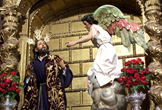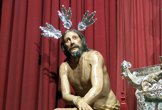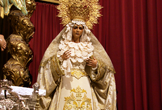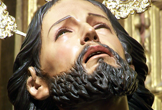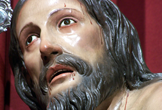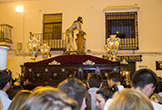Brotherhood of Our Father Jesus of the Prayer in the Orchard, Lord Tied to the Column and Holy Mary of Candlemasand Saint Eloy Bishop.
HISTORY.
It was founded at the beginning of the 17th century in the former Parish of San Nicolás de la Ajerquía. After experiencing a great activity in the 18th century, it lost influence until it disappeared in 1961. From that date on, it went through a series of attempts of reorganisation which were successful in 1975. In 1977 it was transfered to the current Parish of San Francisco and San Eulogio, and it incorporated the image of Señor Amarrado a la Columna (Lord Tied to the Column), together with María Santísima de la Candelaria (Holy Mary of Candlemas). In 1992, the Brotherhood also included San Eloy Obispo (Saint Eloy Bishop).
TEMPLE.
Church of San Francisco and San Eulogio. This temple was the former convent of San Pedro el Real, a Fernando III’s foundation that belonged to the Franciscans until the expropiations in the 19th century.
THE IMAGES.
Nuestro Padre Jesús de la Oración en el Huerto (Our Father Jesus of the Prayer in the Orchard) – [PHOTO #1; #2]
It is an anonymous work, which is thought to date back to the 17th century, when it was worshipped in the former Parish of San Nicolásand San Eulogioin the popular neighbourhoord of Axerquía.
The scene represents the moment when, after the Last Supper, Jesus heads for the Orchard of Gethsemane, at the footof the Mount of Olives, accompanied by Peter, Saint James, and John. When he was completely alone, he fell down with his face on the ground and begged: “Father, if you are willing, take this cup from me; yet not my will, but yours be done“. Then, an angel from heaven appeared to confort him and, in agony, he insisted on his prayer.
The image of Nuestro Padre Jesús de la Oración en el Huerto (Our Father Jesus of the Prayer in the Orchard) is conceived to be kneeling, while slightly turning his head towards the angel. His hair seems to be moved by a strong wind, thus leaving his forehead clear. His hands are very real and soft, as well as the feet, of which we can appreciate even the smallest anatomical detail.
There is great speculation about the author of this work, although nowadays it seems that the most accepted theory is the one pointing at the circle of Pedro de Mena as Alberto Villar suggested.
The scene is completed by the figure of an Angel; the first sculpture was substituted by another one at the end of the 40s; this image has a natural size and was made in plaster by Camacho, who was inspired by the Angel made by Francisco Salzillo in the 18th century for Hermandad de la Oración en el Huerto(Brotherhood of Prayer in the Orchard) of the Holy Week in Murcia. This figure was in procession until 1982, when the brotherhood commissioned a new sculpture to Miguel Arjona. It is carved in pine wood from Flanders and polychrome, following the tradition of the religious sculptors in Andalusia in the 18th century.
Nuestro Padre Preso y Amarrado a la Columna (Our Father Prisoner and Tied to the Column) – [PHOTO #1; #2]
In the 19th century, when the brotherhood of Jesus in the Garden was taken to the Church of San Francisco and San Eulogio, the brotherhood included the image of Nuestro Padre Preso y Amarrado a la Columna (Our Father Prisoner and Tied to the Column), which was worshipped in the Conventual Church of the Franciscan Fathers. Like in the previous case, there has been speculation about the author of this image, although we only know for sure that it comes from Granada.
The scene represents the moment when Jesus is tied to the column to be flogged as punishment; in fact, in the past the image went in procession accompanied by two executioners and a Roman. That is why the sculpture shows the severity of the wounds caused by the Romans’ lashings. However, the pain has not darkened the tenderness in Christ’s expression.
Jesus is represented leaning on a column, with his hands crossed and looking at the sky. It is a slim Christ but with some muscles, where we can see details such as the veins and bones in his joints and thorax.
Nuestro Padre Preso y Amarrado a la Columna (Our Father Prisoner and Tied to the Column) did his last station of penance in 1962, and in 2003, when it was restored for the last time (by José A. Navarro), it was finally included in the processional parade.
María Santísima de la Candelaria (Holy Mary of Candlemas) – [PHOTO #1; #2]
At the end of 1974 it is agreed to substitute the old image of María Santísima de los Siete Dolores Gloriosos (Holy Mary of the Seven Glorious Pains) by a new image and they decided to change the name to María Santísima de la Candelaria (Holy Mary of Candlemas), very linked to the neighbourhood of San Francisco, with a great tradition among the neighbours. The work was commissioned to Antonio Rubio that same year.
The image has an oval face and hazel eyes; her mouth is small, with parted lips, thus creating a greater dramatic feeling. Her hands are opened, with slightly bended fingers.
NAZARENE HABIT.
Dark green tunic, white face-coverer and cape, Franciscan cincture and white buttons.
IMPORTANT INSIGNIAS.
Carved nickel silver Guiding Cross by silversmith from Seville Manuel de los Ríos (1979).
Carved nickel silver lanterns from the workshop of Sons of Juan Fernández in Seville.
Carved nickel silver horns from the same workshop with olive green velvet cloths designed by Rafael Carmona and Rafael Gavilán and embroidered in the workshops of the brotherhood.
Senatusbanner from the workshop of Sons of Juan Fernández with olive green velvet cloth by Rafael Carmona and Rafael Gavilán. Anonymous silver chalice from the 17th century which is carried in procession on a green velvet cushion.
Banner of the brotherhood in the shape of a labarum, made in olive green velvet with gilded embroidery, by Antonio Rincón.
Virgin banner donated by the Association of Silversmiths, Jewellers and Watchmakers of Córdoba. It has paintings by Luis López Perea from Córdoba and gilded embroidery by Piedad Muñoz Rodríguez’s workshop, designed by Brother Ricardo of Córdoba.
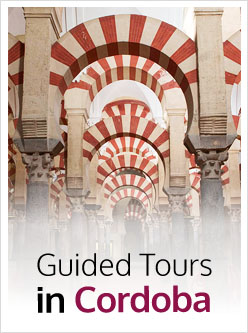

Elige el tour que más se ajuste a tus necesidades y reserva tu plaza en una de nuestras visitas guiadas regulares.
Las Visitas guiadas regulares son aquellas a las que puedes apuntarte de forma individual, se realizan regularmente y en un solo idioma, castellano o inglés
Visita Guiada Mezquita-Catedral de Córdoba
5 / 5
13€
Visita Guiada Mezquita de Córdoba y Judería
5 / 5
Desde
17€
Visita Guiada Córdoba a Fondo
5 / 5
Desde
40€
Visita Guiada Medina Azahara
5 / 5
Desde
18€


